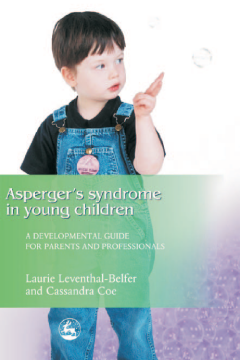
Additional Information
Book Details
Abstract
Asperger's Syndrome in Young Children is easy to read, with lots of practical ideas and advice, presented in a sympathetic manner. It would be most useful for teachers or professionals who are new to the field or parents who believe their child may be on the Asperger's syndrome spectrum. It is a valuable source of information on strategies for helping young children with Asperger's syndrome to realise their full potential.'
- ChildrenNow
This landmark book focuses on how AS presents in pre-school children. An essential guide for parents coming to terms with their child's AS diagnosis and for the professionals who work with this age group, it is unique in answering pressing questions specific to younger children. How can parents help their AS child to develop speech and language? What help is available at school and home? When, if at all, should a child be informed about AS? Including a useful summary of early childhood development stages, Leventhal-Belfer and Coe provide a diagnostic model based on assessment of the child in contrast to 'neurotypical' children, considering relationships at home, in school or in care. Their book shows how to develop tailored early intervention strategies and to assist parents, teachers and mental health professionals in making informed decisions to nurture the development of AS children.
Laurie Leventhal-Belfer is the Founder and Director of Friends Connections, a therapeutic group program for young children with Asperger's Syndrome and their families. She is also a Clinical Assistant Professor in the Department of Psychiatry and Behavioral Sciences, Stanford University School of Medicine. She lives with her husband, son, daughter and beagle. Cassandra Coe is a clinical social worker. She has dedicated her career to addressing the mental health and developmental needs of young children and has been involved in teaching, mentoring and providing assessment and treatment services to a wide range of children and families. She lives in San Francisco with her husband and two young children.
Table of Contents
| Section Title | Page | Action | Price |
|---|---|---|---|
| Contents: | |||
| 1. Introduction: A Summary of the Argument | |||
| 2. Africa in 2005: the long view: Five dimensions of Africa’s problems | |||
| 3. The truth about trade: Trade policy debates; The role of development states; ‘Policy space’ and anti-developmental states; Summing up | |||
| 4. Aid, debt relief and conditionality: The case for (more) aid; The conditionality debate; The politics of conditionality; An impasse for NGOs and donors; Summing up | |||
| 5. The limits of ‘governance’: Africa’s record on governance; The rise and fall of governance reform; Assessing the governance problem | |||
| 6. Politics in Africa: The roots of clientelism; Managing instability (or not); The multi-party variant of clientelism | |||
| 7. The state they’re in: Explaining weak states; The impact of economic reforms; | |||
| 8. Are developmental states now emerging in Africa?: Botswana; Uganda; Ghana; Tanzania; Mozambique; An open verdict | |||
| 9. What will a developmental state in Africa look like?: Political form; Access to the state; Leadership | |||
| 10. Towards developmental states in Africa – what agenda for international action?: | |||
| An agenda for aid; An agenda for trade; An agenda for coherence; An agenda for the UK government; An agenda for campaigning NGOs | |||
| Notes | |||
| Bibliography | |||
| Index |
